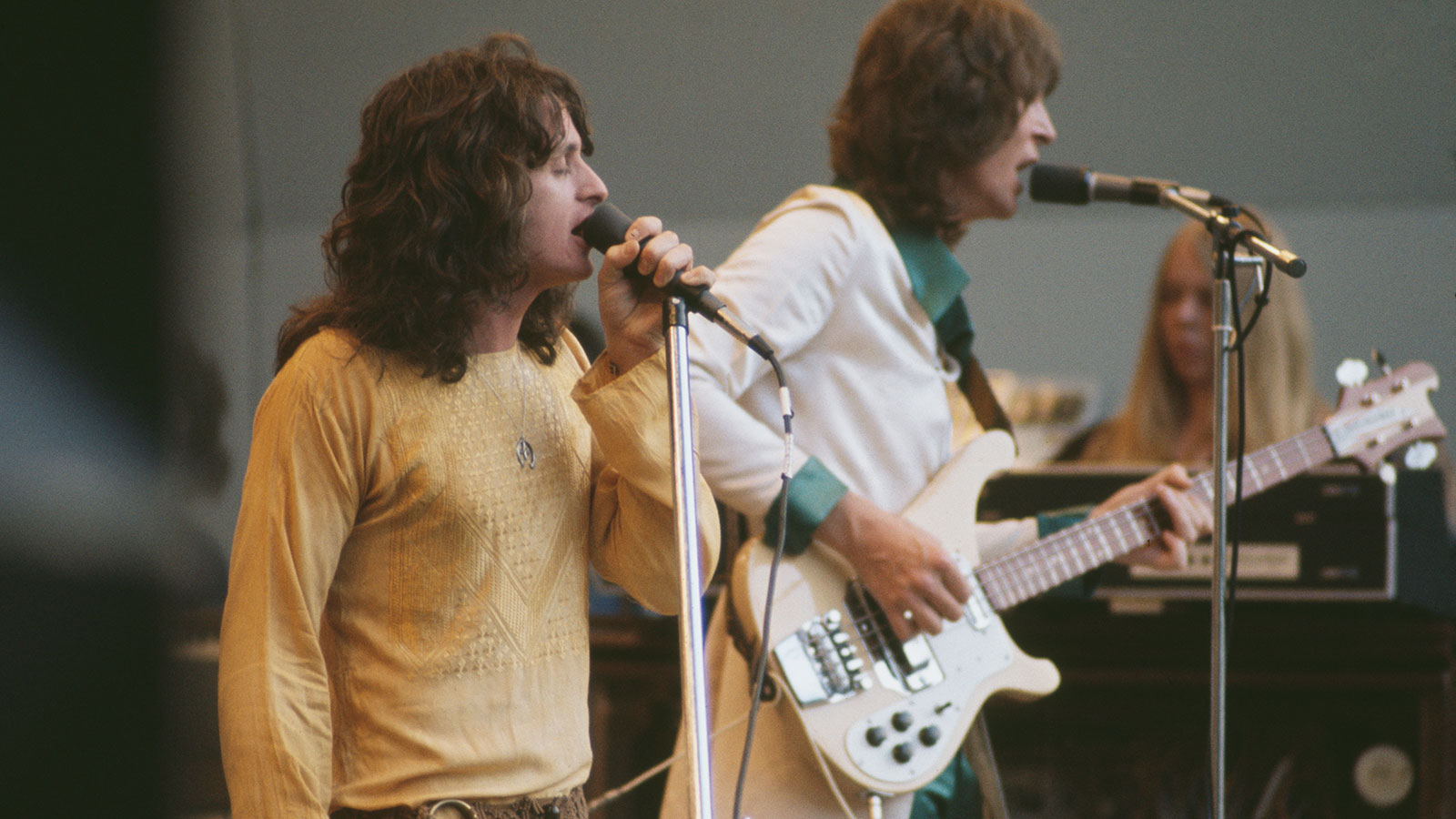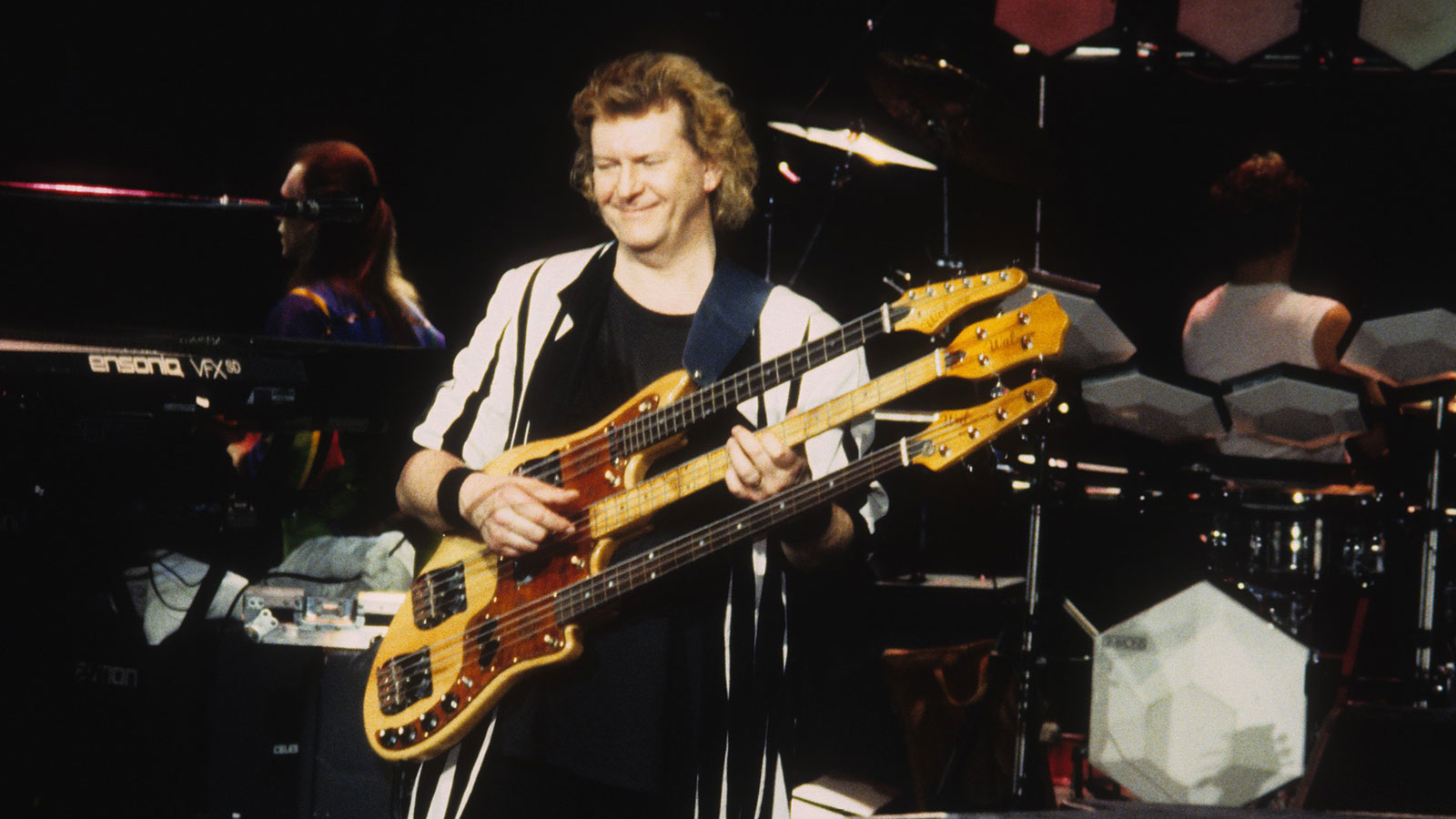How Chris Squire got his iconic bass tone
The evolution of the Yes man’s incredible low-end sound

The classic Chris Squire bass tone is best described as ‘clanky’, ‘clacky’, ‘brittle’, ‘hollow’ and so on, but rather than deciphering endless adjectives it’s probably best to listen to Roundabout and marvel at its prominent, treble-loaded tone, delivered with startling picking speed and agility.
Squire referred to the bass part as “quintessential” with some humour, having been asked about it so many times over the years, but he was right – it perfectly sums up his approach to the bass guitar.
Squire was best known for playing a 1964 Rickenbacker bass with the serial number DC127, often thought to be a regular 4001S model. It was actually an RM1999, in other words an import into the UK by Rose Morris, Rickenbacker’s official British importer at the time.
Asked by Nick Beggs why he chose a Ricky, Squire explained: “Because when they originally came into England, Pete Quaife from the Kinks bought one, and John Entwistle bought one. I worked at [guitar shop] Boosey & Hawkes, who were the importers, and I got the third one.
“It’s a brilliant, brilliant guitar... I have a relationship with it, it just plays itself, really. The pickups are all cockeyed and crappy; by modern standards they wouldn’t figure as being efficient at all. But it’s the inefficiency that makes it so good.”
Squire’s Rickenbacker underwent several drastic changes over the years, the most radical coming when he rewired the single-output bass with stereo outputs in the early Seventies. His idea was that certain effects worked better with either the neck or bridge pickup, a concept copied by a few notable bassists over the years.
Squire’s Rickenbacker underwent several drastic changes over the years... and he rewired the single-output bass with stereo outputs in the early Seventies
“I invented that whole thing!” he told Beggs. “I didn’t do it because I wanted to play in stereo,” Squire told Brian Fox. “It’s because I loved the fuzz tone I could get from the [neck] pickup, but with the bridge pickup, the fuzz was horribly nasal sounding. All of my guitars have stereo outputs for that reason. With new innovations through the years, these little nuances have come into play and been part of my development.”
Get The Pick Newsletter
All the latest guitar news, interviews, lessons, reviews, deals and more, direct to your inbox!
In addition, he covered the bass in flowery wallpaper in the hippie era, but when he wanted to move on from that look, removing the paper also entailed the removal of the original Fireglo finish. He then covered it with silver paper, and once again, this needed to be sanded off when he grew tired of it.

His tech applied a cream lacquer finish to the bass, which now weighed a bit less than a regular Rickenbacker: this was a factor in its sound, said Squire, although it’s unknown if this was ever professionally assessed. His signature 4001CS bass, when it was launched in 1991, didn’t sound exactly like the original, though, so maybe he was onto something.
More modifications were made in the mid-Eighties by luthier Michael Tobias, who told Fox: “If I remember correctly, the peghead had been broken off more than once. When I got the bass, it was hanging by a thread, and there was almost no glue surface left. The break was almost straight through under the nut. Because of the way Rickenbacker cut out the truss-rod access, there wasn’t much area to re-bond.
The two basses which received the most attention were a Wal triple-neck given to him by Rick Wakeman and a green Jim Mouradian bass
“I got a new rod system from Rickenbacker and made a scarf joint so there’d be some area to glue. I recreated the original peghead with the proper wood, attached it, shaped it to the existing neck profile, and matched the paint.”
It emerged that the RM1999’s bridge pickup, which Squire referred to as having a “tinny sound”, was defunct by the time Tobias got to it. “It was actually dead,” Tobias told Fox. “I installed a new pickup from Rickenbacker, but Chris didn’t like it, so I put the old pickup back in. It would pick up a little from the working pickup and make some sound, but not on its own.”

Squire used a dozen or so basses across his career, including four-strings from Lakland, Tobias, MPC and Yamaha, a Ranney eight-string and Fender Telecaster and Jazz basses.
As well as the original Rickenbacker, the two basses which received the most attention were a Wal triple-neck given to him by Rick Wakeman and a green Jim Mouradian bass.
A Marshall Super Bass 100-watt head was Squire’s preferred option, though, sometimes with custom 6x12” cabs made by Clair Brothers
The former featured doubled A, D, and G strings at the top, a fretted four-string in the centre and a fretless four-string on the bottom – and, along with Geddy Lee’s twin-neck Rickenbacker, is probably the ultimate prog-rock instrument.
Of the Mouradian, he explained in a webchat: “Jim Mouradian and myself designed the bass. The way the wood is shaped is in the initials C and S. It looks like a fairly Eighties metal design in a way.”
Fretted basses were where Squire was most comfortable, as he told Nick Beggs: “We just did an acoustic thing where I play a Martin acoustic fretless which I hired from a place in LA. Prior to that I had a Rickenbacker fretless which I didn’t like very much. I had a little Guild fretless that I put it through a Vox AC 30... but I’ve never played fretless like Jaco.”
This being Chris Squire, more tales abound of some genuinely innovative approaches to bass – such as a bass fitted with guitar strings, on which he played four-string chords, and a Gibson double-neck guitar/bass that he played on the song Safe on the Fish Out Of Water album. The innovation here was that he played the bass with only the guitar neck’s pickups switched on, leading to a ringing, resonant tone that didn’t sound remotely like a regular bass.
In all cases, Squire always used a standard-gauge set of Rotosound Swing Bass roundwound strings, attributing some of his tone to this choice.
“The first person I knew to use them was John Entwistle,” he told Fox. “As far as I remember, he was very responsible for developing them with James Howe, who originally started the company. John said to James Howe that he wanted the bass to so like the low end of a grand piano, and that was that. I’m a dyed-in-the-wool Who fan since I was a teen, and I always loved John’s sound, so I tried the strings, too.”
He added: “The story goes that the guys at Rickenbacker got rather upset at me. Because people were putting Rotosound roundwounds on their Rickenbackers, they were wearing down the softer fretwire on those earlier basses.
“When I first visited the Rickenbacker factory, I thought I was going to get a hero’s welcome. But they were like, ‘Come take a look at our repair room,’ where they had a hundred basses that had been returned. We have a good relationship now, but originally we had a rocky start!”
When sampling came into fashion, I took those Dutron and Taurus pedal sounds and blended them into one sampled sound for each note
Chris Squire
Amp-wise, Squire moved through several brands over the years, including the original Sunn rig, as well as SWR and Ampeg. A Marshall Super Bass 100-watt head was his preferred option, though, sometimes with custom 6x12” cabs made by Clair Brothers.
For effects, he had a custom pedalboard made in 1983: at various points over the years, this contained a Maestro Fuzz-Tone, a TC Electronic Stereo Chorus Flanger, a TC Nova Reverb, a Boss OC-3 Super Octave, a Mu-Tron III, an ART SGX Nightbass, a Sound Sculpture router, an MXR 1500 digital delay, and a Korg Digital Reverb. Squire also used Moog Taurus bass pedals and also utilised an X-15 Ultrafoot controller to trigger an E-Mu ESI2000 sampler.
“I originally had a set of Dutron bass pedals that were made in Italy in the Sixties and Seventies,” Squire told Fox. “Later on, when Bob Moog made his Taurus pedals, I had those as well. As time progressed and sampling came into fashion, I took those Dutron and Taurus pedal sounds and blended them into one sampled sound for each note. Now when I play that keyboard with my feet, I’m actually triggering the samples.”
Finally, we should also acknowledge that Squire’s prominent presence in the mix of the early Yes albums helped bring his unique tone and style to the limelight. As he told Nick Beggs, “On The Yes Album and Fragile the bass was still pretty loud and that was down to [producer] Eddie Offord... And all he used to do was whack the UREI compressor right up. That’s what he did.”
Steve Howe, who had just joined the band, said to me, ‘The bass is really loud, isn’t it Chris?’
The bass-heavy mix in the early days may even have been erroneous, he told Beggs: “The producer of Time And A Word, Tony Colton, decided to mix the album on headphones [but] there was no bass response on the headphones. He plugged them into this tinny little headphone socket that had no low end, so he kept saying to Eddie the engineer, ‘More bass, more bass’.
“There was bass in the speakers but none in the headphones. Steve Howe, who had just joined the band, said to me, ‘The bass is really loud, isn’t it Chris?’ And I went, ‘Well, he’s the producer, I guess that’s how he hears it.' And that album came out like that and got all these audiophile magazine reviews saying about how it was the best-sounding record they’d ever heard!”
Joel McIver was the Editor of Bass Player magazine from 2018 to 2022, having spent six years before that editing Bass Guitar magazine. A journalist with 25 years' experience in the music field, he's also the author of 35 books, a couple of bestsellers among them. He regularly appears on podcasts, radio and TV.
“I asked him to get me four bass strings because I only had a $29 guitar from Sears”: Bootsy Collins is one of the all-time bass greats, but he started out on guitar. Here’s the sole reason why he switched
“I got that bass for $50 off this coke dealer. I don’t know what Jaco did to it, but he totally messed up the insides!” How Cro-Mags’ Harley Flanagan went from buying a Jaco Pastorius bass on the street to fronting one of hardcore’s most influential bands











